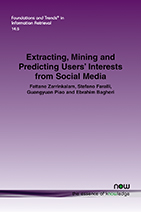Extracting, Mining and Predicting Users’ Interests from Social Media
By Fattane Zarrinkalam, Ryerson University, Canada, fzarrinkalam@ryerson.ca | Stefano Faralli, University of Rome Unitelma Sapienza, Italy, stefano.faralli@unitelmasapienza.it | Guangyuan Piao, Insight Centre for Data Analytics, NUI Galway, Ireland, guangyuan.piao@insight-centre.org | Ebrahim Bagheri, Ryerson University, Canada, bagheri@ryerson.ca
Abstract
The abundance of user generated content on social media provides the opportunity to build models that are able to accurately and effectively extract, mine and predict users’ interests with the hopes of enabling more effective user engagement, better quality delivery of appropriate services and higher user satisfaction. While traditional methods for building user profiles relied on AI-based preference elicitation techniques that could have been considered to be intrusive and undesirable by the users, more recent advances are focused on a non-intrusive yet accurate way of determining users’ interests and preferences. In this monograph, we will cover five important subjects related to the mining of user interests from social media: (1) the foundations of social user interest modeling, such as information sources, various types of representation models and temporal features, (2) techniques that have been adopted or proposed for mining user interests, (3) different evaluation methodologies and benchmark datasets, (4) different applications that have been taking advantage of user interest mining from social media platforms, and (5) existing challenges, open research questions and opportunities for further work.
Extracting, Mining and Predicting Users’ Interests from Social Media
Mining user interests from user behavioral data is critical for many applications. Based on user interests, service providers like advertisers can significantly reduce service delivery costs by offering the most relevant products to their customers. The challenge of accurately and efficiently identifying user interests has been the subject of increasing attention for several years. With the emergence and growing popularity of social media, many users are extensively engaged in social media applications to express their feelings and views about a wide variety of social events/topics as they happen in real time. The abundance of user generated content on social media provides the opportunity to build models that are able to accurately and effectively extract, mine, and predict users’ interests with the hopes of enabling more effective user engagement, better quality delivery of appropriate services, and higher user satisfaction. While traditional methods for building user profiles relied on AI-based preference elicitation techniques that could have been considered intrusive and undesirable by the users, more recent advances are focused on a non-intrusive yet accurate way of determining users’ interests and preferences.
In this monograph, the authors cover five important subjects related to the mining of user interests from social media: (1) the foundations of social user interest modeling, (2) techniques that have been adopted or proposed for mining user interests, (3) different evaluation methodologies and benchmark datasets, (4) different applications that have been taking advantage of user interest mining from social media platforms, and (5) existing challenges, open research questions, and opportunities for further work. The monograph is a valuable resource for those who have familiarity with social media mining and the basics of information retrieval (IR) techniques.
